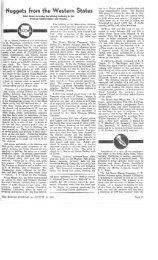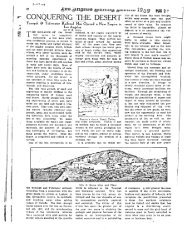Selected Articles from "The Mining Journal" 1944 ... - Vredenburgh
Selected Articles from "The Mining Journal" 1944 ... - Vredenburgh
Selected Articles from "The Mining Journal" 1944 ... - Vredenburgh
Create successful ePaper yourself
Turn your PDF publications into a flip-book with our unique Google optimized e-Paper software.
they were, but at a price of $191 a flask<br />
the mine must have shown a 1943 profit<br />
of at least $1 million. <strong>The</strong> story of New<br />
Idria is the story of dozens of smaller<br />
producers who were amazed and delighted<br />
to find themselves under a ceiling higher<br />
than the highest average price they had<br />
ever experienced.<br />
"New names have appeared in the business.<br />
Second biggest producer after the<br />
New Idria is the two-year-old Bonanza<br />
II, at Yellow Pine, Idaho (4,261 flasks in<br />
1943), followed closely by the original<br />
Bonanza (3,294 flasks), at Sutherlin,<br />
Douglas County, Oregon. Both 8re controlled<br />
by the appropriately named Bonanza<br />
Mines, Inc., a stock company reorganized<br />
by S. R. Smith of San Francisco, a<br />
veteran gold-mine operator. Three of the<br />
Bradley mines-Reed, Sulphur Bank, and<br />
Mount Diablo, all in California-were<br />
among the first 10. <strong>The</strong> old New Almaden,<br />
owned by eastern entrepreneurs, employs<br />
as general manager an outstanding quicksilver<br />
authority, C. N. Schuette, but last<br />
year turned out less than 1,200 flasks."<br />
<strong>The</strong> article continues with a discussion<br />
of the European cartels, their activities in<br />
the control of prices and production, and<br />
something as to the future for the industry.<br />
It concludes with the statement that<br />
the boom is not only over, but that extinction<br />
may lie ahead for most operators,<br />
even if the government does establish a<br />
policy of buying a certain amount of domestic<br />
production at a fixed price in the<br />
interests of national safety. This opinion<br />
is based on the belief that few U. S.<br />
producers could survive at a price of $75<br />
a flask, the figure to which many miners<br />
pr.edict the price will drop. <strong>The</strong> chief<br />
hope of the industry lies in the development<br />
of new uses for the metal, the mercury-powered<br />
turbine at present being the<br />
most promising. Three such power plants<br />
have been completed and are in use, the<br />
largest being 20,OOO-kilowatt generators,<br />
each of which uses around 4,000 flasks<br />
of mercury or about 25 per cent of U. S.<br />
prewar annual output.<br />
THREE EAGLE-PICHER MINES<br />
CLOSED BY LABOR SHORTAGE<br />
AGLE-PICHER MINING AND SMELT<br />
E ING COMPANY has announced that<br />
it has been forced to suspend operation<br />
of three of its major mines and its Bird<br />
Dog central mill near Picher, Oklahoma,<br />
because of an acute labor shortage. <strong>The</strong><br />
company also is said to have cut production<br />
by about one-half at its Galena, I¥'nsaB,<br />
smelter for the same reason.<br />
Eagle-Picher, which is the largest producer<br />
of war-vital zinc and lead concentrates<br />
in the Oklahoma-Kansas-Missouri<br />
mining district, is shifting the crews <strong>from</strong><br />
the three abandoned mines to other operations<br />
to fill personnel gaps caused by<br />
military inductions. Eagle-Picher <strong>Mining</strong><br />
and Smelting Company, a whollr owned<br />
subsidiary of the Eagle-Picher Lead Company,<br />
is headed by Joseph M. Bowlby,<br />
American Building, Cincinnati Ohio. D. C.<br />
·McKallor, of the same address, is general<br />
manager of all mining and smelting operatioM.<br />
PGfI, 10<br />
REFINED COPPER UP IN APRIL<br />
BLISTER PRODUCTION DOWN<br />
OPPER production for the month of<br />
C April, as reported by the Copper Institute,<br />
amounted to 95,280 tons of refined<br />
U. S. duty-free copper, compared<br />
with an output of 99,118 tons in March<br />
and 87,128 tons in February. At the end<br />
of April refined stocks on hand, at refineries,<br />
on consignment, and in exchange<br />
warehouses, but not including consumers'<br />
stocks at their plants, amounted to<br />
38,382 tons, an increase of 1,123 tons over<br />
stocks at the end of March. However,<br />
stocks of blister copper decreased 3,243<br />
tons during April, following an increase<br />
of 2,171 tons in March, and 8,585 tons in<br />
February. As a result, total stocks of<br />
copper at the end of April were down<br />
2,120 tons.<br />
In its preliminary estimate of copper<br />
production for March, the United States<br />
Bureau of Mines reports an output of<br />
93,617 tons <strong>from</strong> domestic mines, an increase<br />
of 6,265 tons over that in February.<br />
<strong>The</strong> average daily production in<br />
March was 3,020 tons, an increase of 8<br />
tons <strong>from</strong> the average daily production<br />
for February and an increase of 39 tons<br />
<strong>from</strong> the average daily production of 2,981<br />
tons for 1943. <strong>The</strong> production <strong>from</strong> the<br />
combined western states increased 6,100<br />
LITTLE MAN yOU HA.VE<br />
A DIZZY DAZE/"<br />
tons (7.4 per cent) in March as compared<br />
with February. In the eastern<br />
states the increase was 59 tons of recoverable<br />
copper. while the central states reported<br />
an increase of 106 tons over February<br />
production.<br />
<strong>The</strong>re were increases of varying magnitudes<br />
in the production <strong>from</strong> all of the<br />
copper producing states of the West in<br />
March. <strong>The</strong> largest increase was noted in<br />
Arizona production, where the Morenci<br />
plant worked at full capacity throughout<br />
the month, producing about 1,500 tons<br />
more recoverable copper than in February,<br />
the total production being the great;.<br />
est ever recorded for that property. Gains<br />
in output in March over February also<br />
were noted at Inspiration, Miami, Castle<br />
Dome, Nevada Consolidated, and New<br />
Cornelia.<br />
<strong>The</strong> March production <strong>from</strong> Montana<br />
mines also was the highest recorded this<br />
year and was due to a steady increase in<br />
output of copper <strong>from</strong> the Anaconda Copper<br />
<strong>Mining</strong> Company's properties at Butte.<br />
<strong>The</strong> output <strong>from</strong> New Mexico increased<br />
about 1,900 tons in March due to an increase<br />
in the output <strong>from</strong> Kennecott Copper<br />
Corporation mines at Santa Rita, New<br />
Mexico. A substantial increase also Wal<br />
noted in production <strong>from</strong> the Utah Copper<br />
Company in Utah.<br />
THE MINING JOURNAL for MAY 30, 11.14















